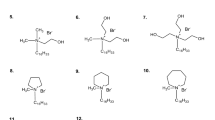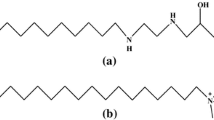Abstract
Computer-assisted methods were employed to develop a statistical relationship between molecular-based structural parameters and log critical micelle concentration (CMC) of some anionic surfactants. The CMC of 31 alkyl sulfates and alkanesulfonates were used for model generation. Among different models, two equations were selected as the best, and their specifications are given. The statistics of these models together with cross-validation results indicate the capability of both models to predict the CMC of anionic surfactants. Three descriptors of Wiener number, reciprocal of the dipole moment, and reciprocal of the Randic index appear in the models. Results indicate that topological characteristics, such as compactness and branching of anionic surfactants, play major roles in micelle formation. Polarity of the molecules is also important, but its effect is less than that of topology of the surfactants.
Similar content being viewed by others
References
Crudden, J.J., B.J. Lambert, and R.W. Kohl, Applications of N-Acyl Sarcosine Surfactants, in Industrial Applications of Surfactants III, edited by D.R. Karsa, Royal Society of Chemistry, Cambridge, 1992, p. 95.
Kabara, J.J., W.J. McKillip, and E.A. Sedor, Aminimides: I. Antimicrobial Effect of Some Long Chain Fatty Acid Derivatives, J. Am. Oil Chem. Soc. 52:316 (1975).
Infante, M.R., J. Molinero, P. Bosch, M.R. Judia, and P. Erra, Lipopeptidic Surfactants: I. Neutral N-Lauroyl-l-arginine Dipeptides from Pure Amino Acids, 66:1835 (1989).
Xia, J., Y. Xia, and I.A. Nananna, Structure-Function Relationship of Acyl Amino Acid Surfactants: Surface Activity and Antimicrobial Properties, J. Agric. Food Chem. 43:867 (1995).
Brooks, S.H., A. Berthod, B.A. Krisch, and J.G. Dorsey, Flow-Injection System for Determination of Critical Micelle Concentrations of Ionic and Nonionic Surfactants, Anal. Chim. Acta 209:111 (1988).
Rosen, M.J., Surfactants and Interfacial Phenomena, John Wiley & Sons, New York, 1989, p. 108.
Yaroshenko, N.A., and Zh.M. Aryamova, Accounting for Surface Tension in the Determination of Critical Micelle Concentration for Aqueous Solutions of Ionic Surfactants, Ukr. Khim. Zh. 51:466 (1985).
Corno, C., E. Platone, and S. Ghelli, Carbon-13 NMR Analysis of Polyoxyethylenated Surfactants Determination of Critical Micellar Concentration, Colloid Polym. Sci. 262:667 (1984).
Furton, K.G., and A. Norelus, Determining the Critical Micelle Concentration of Aqueous Surfactant Solutions: Using a Novel Calorimetric Method, J. Chem. Educ. 70:254 (1993).
Mandal, A.B., B. Nair, and D. Ramaswamy, Determination of Critical Micelle Concentration of Surfactants Using Cyclic Voltametry, Bull. Electrochem. 4:565 (1988).
Vollhardt, D., The A.C. Polarographic Method for the Simple Direct Determination of the Critical Micelle Concentration, Tenside Deterg. 12:225 (1975).
De Vendittis, E., G. Palumbo, G. Parlato, and V. Bocchini, A Fluorimetric Method for the Estimation of the Critical Micelle Concentration of Surfactants, Anal. Biochem. 115:278 (1981).
Nakamura, H., A. Sano, and K. Matsuura, Determination of Critical Micelle Concentration of Anionic Surfactants by Capillary Electrophoresis Using 2-Naphthalenemethanol as a Marker for Micelle Formation, Anal. Sci. 14:379 (1998).
Kawakatsu, T., K. Kawasaki, and F. Hirofumi, Theories and Computer Simulations of Self-Assembling Surfactant Solutions, J. Phys. Condens. Matter 6:6385 (1994).
Karaborni, S., K. Esselink, P.A.J. Hilbers, and B. Smit, Simulating Surfactant Self-Assembly, 6 (Suppl. 23A):A351 (1994).
Zoller, N.J., A. Shiloach, and D. Blankschten, Predicting Surfactant Solution Behavior, CHEMTECH 26:24 (1996).
Van Helden, A.K., Computer Simulation Studies of Surfactant Systems, Prog. Colloid. Polym. Sci. 100:48 (1996).
Porter, M.R. Handbook of Surfactants, 2nd edn., Chapman & Hall, New York, 1994, p. 116.
SPSS/PC, The Statistical Package for IBM PC, Quiad Software, Ontario (1986).
MOPAC, Version 6, U.S. Air Force Academy, Colorado Springs.
HyperChem, Release 3 for Windows, Molecular Modeling System, HyperCube, Inc. and Autodesk Inc. (1993).
Van Os, N.M., J.R. Haak, and L.A.M. Rupert, Physico-chemical Properties of Selected Anionic. Cationic and Nonionic Surfactants, Elsevier Science Publishers, New York, 1993, p. 9.
Wiener, H., Structural Determination of Paraffin Boiling Points, J. Am. Chem. Soc. 69:17 (1947).
Randic, M., Rearrangement of the Connectivity Matrix of a Graph Reply to Comments, J. Chem. Phys. 62:309 (1975).
Balaban, A.T., Highly Discriminating Distance-Based Topological Index, Chem. Phys. Lett. 89:399 (1982).
Stouch, T.R., and P.C. Jurs, A Simple Method for the Representation, Quantification and Comparision of the Volumes and Shapes of Chemical Compounds, J. Chem. Inf. Comput. Sci. 26:4 (1986).
George, D., and P. Mallery, SPSS/PC+Step By Step, A Simple Guide and Reference, Wadsworth Publishing Company, 1995, p. 168.
Cramer, R.D., D.E. Patterson, and J.D. Bunce, Comparative Molecular Field Analysis (Comfa). 1. Effect of Shape on Binding of Steroids to Carrier Proteins, J. Am. Chem. Soc. 110:5959 (1988).
Mihalic, Z., and N. Trinajstic, A Graph-Theoretical Approach to Structure-Property Relationships, J. Chem. Educ. 69:701 (1992).
Stache, H.W., Anionic Surfactants, Organic Chemistry, Vol. 56, Marcel Dekker, New York, 1996, p. 243.
Kovtunenko, L.I., N.I. Smirnov, and N.P. Titova, Surface and Rheological Properties of Aqueous Solutions of Sodium Monoalkylsulfonates, Zh. Prikl. Khim. 48:323 (1975).
Wright, K., and H.V. Tartar, Solubilities, Micelle Formation and Hydrates of the Sodium Salts of the Higher Alkylsulfonates, J. Am. Chem. Soc. 61:539 (1939).
Author information
Authors and Affiliations
Corresponding author
About this article
Cite this article
Jalali-Heravi, M., Konouz, E. Prediction of critical micelle concentration of some anionic surfactants using multiple regression techniques: A quantitative structure-activity relationship study. J Surfact Deterg 3, 47–52 (2000). https://doi.org/10.1007/s11743-000-0112-5
Received:
Accepted:
Issue Date:
DOI: https://doi.org/10.1007/s11743-000-0112-5




